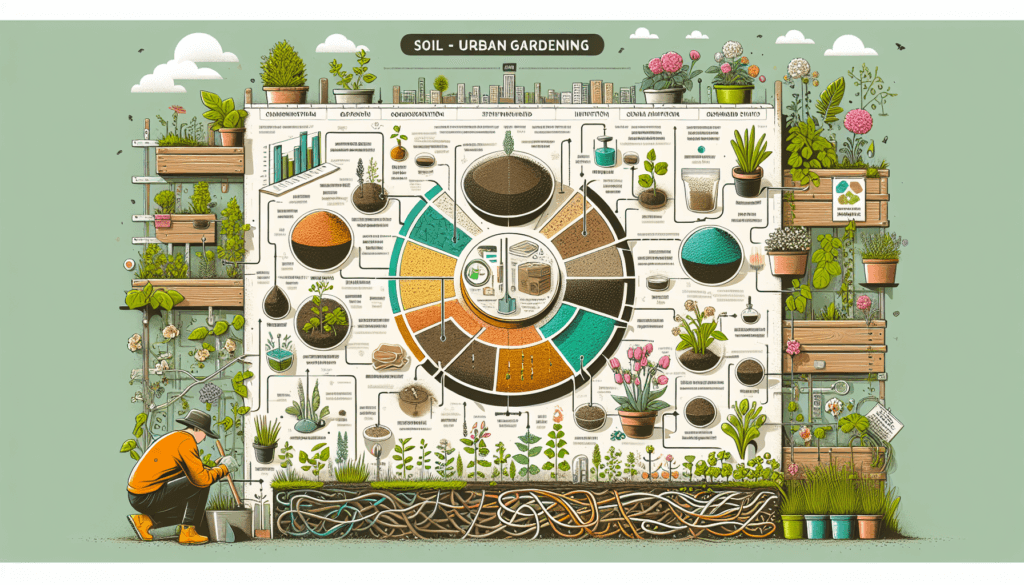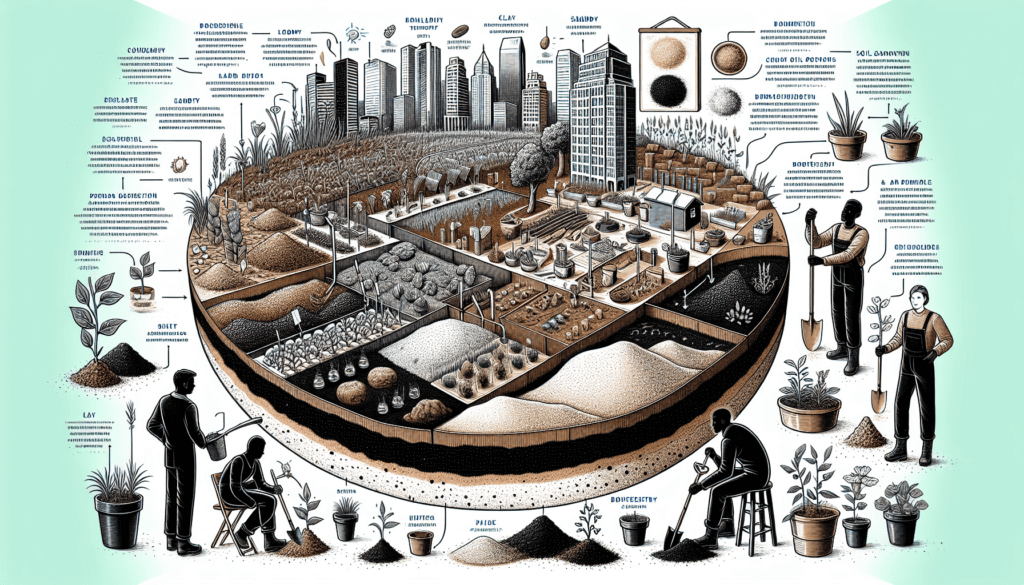Are you ready to turn your concrete jungle into a flourishing oasis? Discover the essential guide to soil types for urban gardening and unlock the secret to growing a bountiful garden right in the heart of the city. Whether you have a small balcony or a spacious rooftop, understanding soil types is crucial for successful urban gardening. From loamy soil to sandy soil, each type holds its unique properties, determining the plants that will thrive in your urban oasis. Join us on this journey as we delve into the world of soil and empower you with the knowledge to create a green haven amidst the bustling urban landscape.

Understanding Soil Composition
The Basics of Soil
Soil is the foundation of any garden, providing essential nutrients and support for plants to grow and thrive. Understanding the composition of soil is crucial for successful urban gardening. Soil is composed of various components, including minerals, organic matter, water, and air pockets. These components interact to create a suitable environment for plants to establish their roots and absorb nutrients.
Components of Soil
Minerals: Soil contains minerals such as sand, silt, and clay, which contribute to the texture and structure of the soil. These minerals also help retain water and provide essential nutrients for plant growth.
Organic Matter: Organic matter includes dead plant material, animal waste, and decomposed organic substances. It provides nutrients, improves soil structure, and enhances water retention capacity.
Water: Soil acts as a reservoir for water, allowing plants to access it as needed. Proper moisture levels are crucial in maintaining plant health.
Air Pockets: Soil contains small air pockets that allow for oxygen exchange, which is essential for root respiration and nutrient uptake.
Importance of Soil Composition
Understanding soil composition is vital for urban gardening for several reasons:
Nutrient Availability: Different plants have specific nutrient requirements, and soil composition plays a significant role in determining nutrient availability. By understanding the composition, urban gardeners can amend their soil to provide optimal nutrient levels.
Water Movement: Soil composition affects water movement within the soil. Sandy soil drains quickly but can be challenging to retain moisture, while clay soil holds onto water for longer but may become compacted. Understanding soil composition helps gardeners manage water effectively.
Plant Selection: Different plants thrive in different soil conditions. By understanding soil composition, urban gardeners can choose plant varieties that are best suited to their specific soil type, ensuring successful growth and productivity.
Soil Fertility: Soil composition affects fertility, which in turn impacts plant growth and productivity. By understanding soil composition, urban gardeners can determine the fertility level of their soil and amend it accordingly to support healthy plant growth.
Topsoil vs. Subsoil
Definition and Characteristics
Topsoil and subsoil are two distinct layers of soil, each playing a crucial role in urban gardening.
Topsoil: The topsoil layer is the uppermost layer of soil, approximately 5-10 inches deep. It is rich in organic matter and nutrients, making it a favorable environment for plant growth.
Subsoil: Subsoil is the layer beneath the topsoil, extending deeper into the ground. It typically contains lower levels of organic matter and fewer nutrients compared to topsoil.
Differences in Composition
The composition of topsoil and subsoil differs significantly:
Organic Matter: Topsoil has a higher concentration of organic matter, while subsoil contains comparatively less.
Nutrient Levels: Due to the presence of organic matter, topsoil generally has higher nutrient levels, making it more fertile than subsoil.
Soil Structure: Topsoil is typically looser and easier to cultivate, while subsoil is denser and more compacted.
Importance in Urban Gardening
Understanding the differences between topsoil and subsoil is crucial for urban gardening:
Plant Growth: Topsoil provides the ideal conditions for plant growth, offering the necessary nutrients and organic matter. Urban gardeners should focus on building and maintaining healthy topsoil to support optimal plant growth.
Water Management: The composition of topsoil and subsoil influences water movement and drainage. Proper water management is essential to prevent waterlogging or drought, ensuring healthy plant growth.
Soil Health: Topsoil is the primary layer that sustains soil health and fertility. Urban gardeners should prioritize the health of their topsoil through regular amendments and organic matter additions to support long-term plant growth.

Sandy Soil
Characteristics of Sandy Soil
Sandy soil has distinctive characteristics that urban gardeners should be aware of:
Texture: Sandy soil feels gritty and coarse due to its larger particle size.
Drainage: Sandy soil drains quickly, making it prone to drying out.
Aeration: Due to its loose structure, sandy soil provides excellent aeration to plant roots.
Advantages of Sandy Soil for Urban Gardening
Sandy soil offers several advantages for urban gardening:
Erosion Control: Sandy soil’s excellent drainage helps prevent soil erosion, especially in areas with heavy rainfall.
Warmth: Sandy soil warms up quickly in the spring, allowing for earlier planting and extended growing seasons.
Root Development: The loose texture of sandy soil allows for easy root penetration and growth.
Challenges and Solutions for Sandy Soil
Despite its advantages, sandy soil poses a few challenges for urban gardeners:
Nutrient Leaching: Sandy soil has low nutrient-holding capacity, leading to nutrient leaching. To overcome this challenge, urban gardeners should frequently add organic matter and use slow-release fertilizers.
Water Retention: Sandy soil’s fast-draining nature can cause water to pass through too quickly, resulting in drought stress for plants. To address this, gardeners should add organic matter or moisture-retaining additives and mulch to improve water retention.
Fertility: Sandy soil is typically low in fertility due to its lower levels of organic matter. Gardeners can improve fertility by incorporating compost or well-rotted manure into the soil.
Clay Soil
Characteristics of Clay Soil
Clay soil has its unique set of characteristics:
Texture: Clay soil feels sticky and compact due to its small particle size.
Drainage: Clay soil has poor drainage and tends to hold onto water for longer periods.
Nutrient Retention: Clay soil has high nutrient retention capacity, making it rich in essential plant nutrients.
Advantages of Clay Soil for Urban Gardening
Clay soil offers several advantages for urban gardening:
Retention of Moisture: Clay soil retains moisture for longer periods, reducing water requirements and potential drought stress for plants.
Nutrient Availability: Clay soil holds onto nutrients and releases them slowly, ensuring a steady supply of essential nutrients for plant growth.
Soil Erosion Prevention: Clay soil has excellent cohesion and helps prevent soil erosion in areas with heavy rainfall.
Challenges and Solutions for Clay Soil
While clay soil provides many benefits, it also presents a few challenges for urban gardeners:
Compaction: Clay soil can become easily compacted, restricting root growth and limiting water and nutrient uptake. To prevent compaction, gardeners should avoid working with clay soil when it is wet and incorporate organic matter to improve soil structure.
Drainage Issues: Poor drainage in clay soil can lead to waterlogging, causing root rot and other plant health issues. To improve drainage, gardeners can incorporate organic matter, such as compost or aged manure, into the soil and create raised beds.
Workability: Due to its sticky texture, clay soil can be challenging to work with, especially during wet seasons. Gardeners should avoid working with clay soil when it is wet and amend it with organic matter to improve its workability.

Loamy Soil
Characteristics of Loamy Soil
Loamy soil is considered the ideal soil type for gardening due to its unique characteristics:
Texture: Loamy soil has a balanced mix of sand, silt, and clay particles, giving it a crumbly texture and good drainage.
Nutrient Retention: Loamy soil has good nutrient retention capacity, ensuring a steady supply of essential plant nutrients.
Water Holding Capacity: Loamy soil strikes a balance between drainage and water retention, providing adequate moisture for plants without becoming waterlogged.
Advantages of Loamy Soil for Urban Gardening
Loamy soil provides numerous advantages for urban gardening:
Fertility: Loamy soil is rich in organic matter and has good nutrient availability, promoting healthy plant growth.
Drainage: Loamy soil offers excellent drainage, preventing waterlogging and root rot.
Workability: Due to its balanced texture, loamy soil is easy to work with and cultivate.
Challenges and Solutions for Loamy Soil
While loamy soil is highly desirable, it still poses a few challenges for urban gardeners:
Erosion: Loamy soil can be prone to erosion if left exposed. To prevent erosion, gardeners should cultivate the soil and implement erosion control measures such as mulching or planting ground cover.
Nutrient Depletion: Over time, nutrient levels in loamy soil can decline. Gardeners should regularly amend the soil with organic matter, compost, or fertilizers to maintain optimal nutrient levels.
Moisture Management: Loamy soil’s balance between drainage and water retention must be carefully managed. Gardeners should monitor moisture levels and avoid overwatering or underwatering to ensure plant health.
Silt Soil
Characteristics of Silt Soil
Silt soil possesses unique characteristics that urban gardeners should consider:
Texture: Silt soil has a smooth, flour-like texture due to its fine particle size.
Retention of Nutrients: Silt soil has good nutrient retention capacity and holds onto valuable plant nutrients.
Water Drainage: Silt soil has moderate water drainage capabilities, striking a balance between sandy and clay soils.
Advantages of Silt Soil for Urban Gardening
Silt soil offers several advantages for urban gardening:
Fertility: Silt soil is often rich in nutrients and provides a good foundation for plant growth.
Moisture Retention: Silt soil retains moisture better than sandy soil, reducing water requirements and improving drought resistance.
Workability: Silt soil is relatively easy to work with and cultivates well due to its fine particle size.
Challenges and Solutions for Silt Soil
Despite its advantages, silt soil poses a few challenges for urban gardeners:
Compaction: Silt soil is vulnerable to compaction, inhibiting root growth and reducing water and air circulation. Gardeners should avoid excessive tilling and incorporate organic matter into the soil to improve its structure.
Erosion: Silt soil can be prone to erosion, especially during heavy rainfall. Gardeners should implement erosion control measures such as mulching or planting cover crops to prevent erosion.
Drainage Issues: Silt soil may suffer from drainage problems if compacted or in areas with poor natural drainage. To improve drainage, gardeners can incorporate organic matter, such as compost or aged manure, and create raised beds.

Peaty Soil
Characteristics of Peaty Soil
Peaty soil possesses distinct characteristics that urban gardeners should take into account:
Organic Matter Content: Peaty soil is high in organic matter, consisting mainly of decomposed plant material.
Water Retention: Peaty soil has excellent water retention capacity due to its porous structure.
Acidic pH: Peaty soil tends to be acidic, which can influence plant selection and nutrient availability.
Advantages of Peaty Soil for Urban Gardening
Peaty soil offers several advantages for urban gardening:
Moisture Retention: Peaty soil retains moisture exceptionally well, reducing the need for frequent watering.
Nutrient Availability: Peaty soil holds onto nutrients and gradually releases them over time, ensuring a steady supply to plants.
Soil Structure: Peaty soil’s high organic matter content improves soil structure, allowing for good drainage and aeration.
Challenges and Solutions for Peaty Soil
While peaty soil has many benefits, it presents a few challenges for urban gardeners:
Acidic pH: Peaty soil tends to be acidic, which can limit plant selection. Gardening in peaty soil may require selecting acid-loving plants or adjusting the pH level through soil amendments.
Nutrient Imbalance: Peaty soil may have imbalanced nutrient levels, requiring regular soil testing and amendments to maintain optimal nutrient levels.
Compaction: Peaty soil can be prone to compaction, reducing air circulation and inhibiting root growth. To prevent compaction, gardeners should avoid excessive traffic on the soil and incorporate organic matter to improve the soil’s structure.
Chalky Soil
Characteristics of Chalky Soil
Chalky soil possesses distinct characteristics that urban gardeners should be aware of:
Texture: Chalky soil has a rough texture due to its high calcium carbonate content.
Drainage: Chalky soil offers good drainage due to its porous structure.
Alkaline pH: Chalky soil tends to have an alkaline pH, which can impact plant selection and nutrient availability.
Advantages of Chalky Soil for Urban Gardening
Chalky soil offers several advantages for urban gardening:
Drainage: Chalky soil’s porous structure allows for good drainage, preventing waterlogging and root rot.
Soil Structure: Chalky soil’s rough texture promotes good soil structure, allowing for adequate aeration and root development.
Pest Resistance: Chalky soil tends to deter certain pests, making it advantageous for growing certain plant varieties.
Challenges and Solutions for Chalky Soil
While chalky soil has its benefits, it also poses a few challenges for urban gardeners:
Alkaline pH: Chalky soil tends to have an alkaline pH, which may limit plant selection and nutrient availability. Gardeners may need to adjust the pH level through soil amendments or select plant varieties that thrive in alkaline soil.
Nutrient Availability: Chalky soil’s high pH can make certain nutrients less available to plants. Regular soil testing and targeted nutrient amendments may be necessary to maintain optimal nutrient levels.
Water Availability: Chalky soil’s potentially rapid drainage can result in poor water retention. To address this, gardeners can incorporate organic matter or moisture-retaining additives into the soil and mulch to improve water retention.

Saline Soil
Characteristics of Saline Soil
Saline soil possesses unique characteristics that urban gardeners should consider:
High Salt Content: Saline soil has a high concentration of salts, making it unsuitable for most plant growth.
Poor Drainage: Saline soil typically has poor drainage due to the salt accumulation.
Alkaline pH: Saline soil commonly has an alkaline pH, which can limit plant selection and nutrient availability.
Advantages of Saline Soil for Urban Gardening
Saline soil presents few advantages for urban gardening:
Salt-Tolerant Plants: Some salt-tolerant plant species can thrive in saline soil, which may be advantageous for certain urban gardening applications.
Drought Resistance: Saline soil’s high salt content can help retain moisture, making it more resistant to drought conditions.
Pest Resistance: Saline soil can deter certain pests due to its high salt content.
Challenges and Solutions for Saline Soil
Saline soil poses significant challenges for urban gardeners:
Plant Selection: Saline soil restricts plant selection, as most plant species are intolerant of high salt levels. Urban gardeners should focus on selecting salt-tolerant plant varieties.
Soil Remediation: Saline soil requires extensive soil remediation to lower salt levels and improve soil fertility. This can involve leaching the soil with clean water, incorporating organic matter, and using soil amendments to rebalance nutrient levels.
Water Management: Saline soil’s poor drainage can result in salt accumulation and exacerbate the salinity issue. Efficient water management practices, such as proper irrigation techniques and adequate drainage, are crucial for mitigating these challenges.
Alkaline Soil
Characteristics of Alkaline Soil
Alkaline soil possesses distinct characteristics that urban gardeners should be aware of:
High pH: Alkaline soil has a pH level above 7, indicating high alkalinity.
Low Nutrient Availability: Alkaline soil may have limited nutrient availability due to high pH levels.
Poor Water Retention: Alkaline soil often has poor water retention, making it challenging for plants to access adequate moisture.
Advantages of Alkaline Soil for Urban Gardening
Alkaline soil presents few advantages for urban gardening:
Reduced Soil Diseases: Alkaline soil can suppress certain soil-borne pathogens, reducing the risk of diseases in the garden.
Pest Resistance: Alkaline soil can deter certain pests, making it advantageous for growing specific plant varieties.
Challenges and Solutions for Alkaline Soil
Alkaline soil poses several challenges for urban gardeners:
Poor Nutrient Availability: Alkaline soil’s high pH level can limit nutrient availability to plants. Gardeners may need to amend the soil with organic matter, compost, or specific fertilizers to provide adequate nutrients.
Plant Selection: Alkaline soil restricts plant selection, as most plants prefer neutral or acidic soil conditions. Urban gardeners should focus on selecting plant varieties that are adapted to alkaline soil.
Water Management: Alkaline soil’s poor water retention can lead to drought stress for plants. Gardeners should incorporate organic matter, mulch, and moisture-retaining additives to improve water retention and ensure adequate moisture for plant growth.
In conclusion, understanding soil composition is essential for successful urban gardening. Each soil type offers unique advantages and challenges, which must be taken into account when planning and cultivating urban gardens. By understanding the characteristics, advantages, challenges, and potential solutions for different soil types, urban gardeners can create optimal growing environments, support plant health and productivity, and enjoy the rewards of a thriving urban garden.


